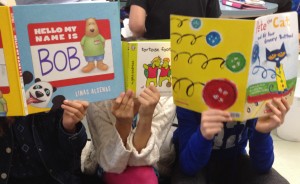Fluency friends is one of the centres in my morning “Literacy Centres” which is my own version of Cafe/Daily Five that I created and implemented on my practicum. In this centre I have a small library of books with Social Emotional Learning Themes. The objective of the centre is to choose a book with a social emotional learning theme and become so fluent at reading it that you can go downstairs and read the book aloud to one of the three K/1 classes!
The students in my class love to be buddies and role models. My class is made up of playground helpers, lunch time monitors, crossing gaurd assistants and all around school leaders! This centre really allowed me to build on my student’s interests and skills and their strong desire to contribute to the greater school community.
Self Awareness, Self Management, Social Awareness, Relationship Skills and Responsible Decision Making are the five core SEL competencies and a high priority for me as far as what I want students to take away from school. The books I’ve chosen for my collections hit on at least one of the five competencies and also have themes such as friendship, diversity or red thoughts and green thoughts.
To start up this centre I first matched each student in the class to a “just right book/good fit book” (or a tiny bit harder!). The nice thing about this centre is there is a range of reading levels available within children’s literature. Everything from books simple enough for early and emergeant readers to read to themselves to more complex books meant for adults to read out loud to children.
There is a lot of wiggle room for me to differentiate and choose the right books for the right student, while still engaging everyone in the same activity and goal. For example for one ELL student I chose “It’s Okay to Be Different” by Todd Parr for the predictable pattern and exposure to new vocabulary. “Odd Velvet” was an excellent fit for a more advanced reader in my class and the theme of the story was particularly relevant to her own personal experiences.
The centre then follows this basic pattern: Read to self- Read to others – Read to a teacher- Perform and Share
Students LOVED reading to K/1 classes. I sent out an email to all the early primary teachers with my list of books and their corresponding themes. Soon the requests were flooding in! Very soon my students were sounding great and ready to share. Students were keeping their books from the morning to revisit at silent reading, think about, practice reading outloud and giving each other notes and feedback.
all while focusing Fluency!
Fluency is an interest of mine ever since being involved in the Language and Literacy Research Lab at Queen’s University when I was in the last year of my undergrad. Under supervision of Dr. Lesly Wade-Woolley and her awesome team of education grad students I completed my senior project on Social Emotional Learning in Children’s Literature which I presented at the conference Inquiry @ Queen’s. While in the lab I was an RA on a large project about reading fluency in grades 4 and 5. This grade has really been identified as a critical transition point as the focus in school starts to change from “learning to read” to “reading to learn”. Everything I learned about fluency and specifically prosody from LWW, JC, LH, AH, and LM in the lab has been invaluable to me, especially when I was placed in a grade five classroom. I knew reading fluency would be a big literacy goal for me to work on with my students.
Reading fluency is about reading texts accurately, relatively quickly and with expression. The expression part has a lot to do with prosody- prosody is really about timing, intonation and stress. For example-readers who are picking up cues from features of text such as punctuation about where in the text to speed up, slow down, pause or add emphasis can read with expression and extract meaning! If readers are too busy struggling to decode words then they can quickly miss out on comprehension.
I will spare everyone further technicalities and just say that fluency and comprehension are linked together in an intimate way! A chicken and egg way, a peanut butter and jelly way, a lock and key way!
To an outside viewer this centre may seem small, but if you ask me more about it, I can tell you all the ways that two years of my own inquiry, research and experience have shaped the way I approached this in my classroom! When I started studying to be a teacher in 2010 at Queen’s Unviersity they used to always tell us we should be “critically relfective professionals”. I don’t know if I really understood what that meant back then, but what it means to me now is that being a teacher means using all your experiences, your knowledge, and your passion to inform even the smallest decisions you make. I like to think that’s what I’ve done with this centre. If anyone were to ask me “Why are you doing this?” I could tell them a million reasons.
–
